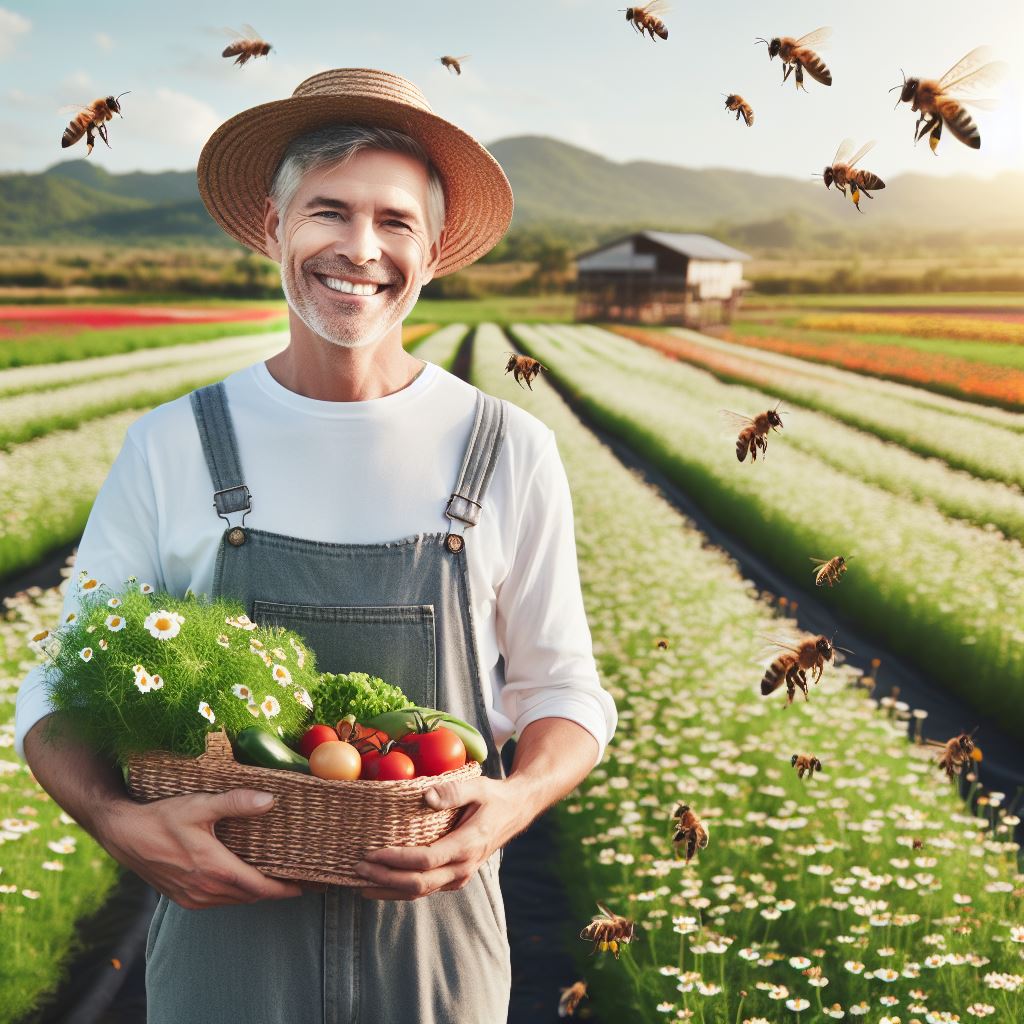Bee-Friendly Farming: A Must for Diversity
Last Updated on February 7, 2024
Introduction
Bee-friendly farming plays a crucial role in promoting diversity in our ecosystem.
Did you know that bees are responsible for pollinating one-third of the world’s food crops?
In this blog section, we will discuss the importance of bee-friendly farming and its key benefits.
In the intricate tapestry of agriculture, where each thread represents a vital component of ecological harmony, bee-friendly farming emerges as a cornerstone of biodiversity preservation.
As the world grapples with the urgent need for sustainable practices, the critical role of bees in pollination and ecosystem health cannot be overstated.
Through conscientious cultivation methods that prioritize the well-being of these essential pollinators, bee-friendly farming not only ensures crop productivity but also nurtures a diverse array of flora and fauna.
Join us as we delve into the intricate web of connections between bees, agriculture, and biodiversity, uncovering the profound significance of embracing bee-friendly practices for the resilience and richness of our ecosystems.
The Importance of Bees in Agriculture
The importance of bees in agriculture cannot be overstated.
They are crucial for pollination, leading to the production of the fruits, seeds, and nuts we enjoy.
Without bees, many crops would struggle to reproduce and provide the yields we rely on for food and economic stability.
A. The crucial role bees play in pollination
Bees play a crucial role in pollination as they visit flowers in search of nectar.
In the process, they inadvertently transfer pollen from male to female flowers, enabling fertilization.
This fertilization is necessary for the plants to produce fruits and seeds.
In fact, it is estimated that bees pollinate around 80% of flowering crops globally.
B. The impact of bee decline on crop yields
The decline in bee populations has a direct impact on crop yields.
With fewer bees, there is reduced pollination, leading to lower fruit set and lower-quality crops.
Studies have shown that fields visited by more bees have higher yields compared to those with limited bee activity.
The decrease in bee populations not only affects farmers’ incomes but also increases costs for both producers and consumers.
C. The economic value of bees in agriculture
From an economic perspective, bees hold immense value in agriculture.
The services they provide through pollination contribute to the global economy, estimated in the billions of dollars.
Many commercial crops, including almonds, heavily rely on bees for pollination.
As crop yields increase with the presence of bees, farmers can generate higher incomes.
However, the decline in bee populations poses a threat to the agricultural industry and its economic stability.
Without sufficient pollination, crop yields decrease, impacting farmers’ profits and potentially leading to economic losses.
It is essential to address bee decline and prioritize bee-friendly farming practices to ensure the productivity and sustainability of agriculture.
Read: Hedgerows: Highways of Biodiversity
The Threats Bees Face
A. Pesticides: A Major Threat to Bee Populations
- Pesticides pose a significant danger to bee populations due to contamination of food sources.
- A class of pesticides known as neonicotinoids has been particularly detrimental to bees.
- These pesticides can impair bee navigation and foraging abilities, leading to colony collapse.
- The widespread use of neonicotinoids must be regulated to safeguard bee populations and agricultural biodiversity.
- Active steps should be taken to reduce pesticide exposure for bees, such as implementing organic farming practices.
B. Habitat Loss: A Negative Impact on Bees
- Habitat loss due to urbanization, deforestation, and monoculture farming has been a major threat to bees.
- Bees rely on a diverse range of flowering plants for their survival and reproduction.
- Loss of natural habitats reduces the availability of food sources and nesting sites for bees.
- The decline in bee populations further disrupts ecosystems, affecting pollination and biodiversity.
- Efforts should be made to preserve and restore natural habitats, creating bee-friendly environments.
C. Climate Change: Effects on Bees
- Climate change poses significant challenges to bee populations and their ability to survive and thrive.
- Rising temperatures disrupt the synchronization between flowering plants and bee activity.
- Bees depend on precise timing to find sufficient nectar and pollen sources for their colonies.
- Changes in temperature and precipitation patterns also impact the availability of floral resources.
- Adaptation strategies, such as planting climate-resilient flowering plants, can help mitigate the effects of climate change on bees.
In fact, bees face various threats that jeopardize their populations and overall biodiversity.
Pesticides, particularly neonicotinoids, serve as a major danger to bees, impairing their abilities and leading to colony collapse.
Habitat loss due to human activities limits food sources and nesting sites for bees, contributing to their decline.
Additionally, climate change disrupts the synchronization between bees and flowering plants, affecting their survival and reproductive success.
Urgent actions are necessary to address these threats and ensure bee-friendly farming practices that prioritize their well-being and the preservation of biodiversity.
By reducing pesticide use, preserving habitats, and embracing climate adaptation strategies, we can create a more sustainable and diverse environment for bees and other pollinators.
Let us recognize the importance of bee-friendly farming and take responsibility for safeguarding these crucial little creatures that play a vital role in our food production and ecosystem.
Read: Cover Crops: Guardians of Biodiversity
Benefits of Bee-Friendly Farming
A. The concept of bee-friendly farming and its practices
Bee-friendly farming focuses on creating an environment that supports the health and well-being of bees.
This approach involves implementing practices that promote biodiversity, reduce pesticide usage, and provide habitat for bees.
To practice bee-friendly farming, farmers can:
- Plant a diverse range of flowering plants that will provide bees with a consistent food source.
- Avoid the use of pesticides that are harmful to bees and other pollinators.
- Incorporate natural pest control methods, such as introducing beneficial insects, to reduce the need for chemical pesticides.
- Provide nesting sites and shelter for bees, such as bee hotels or by leaving some areas of the farm undisturbed.
- Practice sustainable land management techniques, like reducing tillage and maintaining healthy soil, to support a thriving ecosystem.
B. The advantages of creating bee-friendly habitats on farms
- Increased crop yields: Bees play a crucial role in pollination, which is necessary for the reproduction of many crops.
By creating bee-friendly habitats, farmers can attract more bees to their farms, leading to improved pollination and higher crop yields. - Enhanced biodiversity: Bee-friendly farming practices, such as planting a diverse range of flowering plants, promote biodiversity not only among bees but also among other pollinators and beneficial insects.
This increased biodiversity can create a more resilient and balanced ecosystem on the farm. - Improved soil health: Bee-friendly farming often involves practices that support healthy soil, such as reducing chemical pesticide usage and implementing sustainable land management techniques.
Healthy soil is essential for plant growth and nutrient absorption, leading to better crop productivity. - Cost savings: By relying less on chemical pesticides and practicing natural pest control methods, farmers can reduce their pesticide expenses.
Additionally, attracting more bees to the farm can lead to increased pollination rates, reducing the need to invest in expensive artificial pollination methods.
C. The positive effects of reducing pesticide usage
- Protection of honeybees and other pollinators: Pesticides, particularly neonicotinoids, have been linked to the decline in bee populations worldwide.
By reducing pesticide usage, bee-friendly farming helps protect these vital pollinators and contributes to the overall health of ecosystems. - Preservation of biodiversity: Pesticides not only harm bees but also negatively impact other beneficial insects, birds, and wildlife.
By reducing pesticide usage, bee-friendly farming helps preserve biodiversity and supports a healthier and more balanced environment. - Prevention of water and soil contamination: Pesticides can leach into water sources or contaminate the soil, posing risks to human health and the environment.
By reducing pesticide usage, bee-friendly farming minimizes the potential for water and soil pollution, contributing to a cleaner and safer ecosystem. - Healthier and safer food: By reducing pesticide usage, bee-friendly farming contributes to the production of healthier and safer food.
Consumers can enjoy fruits, vegetables, and honey that are free from or have significantly lower pesticide residues, promoting better overall health.
In essence, bee-friendly farming offers numerous benefits, ranging from improved crop yields and enhanced biodiversity to healthier ecosystems and safer food.
By implementing practices that support bee populations and reduce pesticide usage, farmers can play a crucial role in promoting the well-being of bees and protecting the environment.
Read: Natural Pest Control: A Biodiversity Ally
Supporting Biodiversity Through Bee-Friendly Farming
A. How bee-friendly farming contributes to ecosystem diversity
Bee-friendly farming practices play a significant role in supporting and promoting ecosystem diversity.
These practices contribute to the maintenance of a healthier ecosystem by minimizing the use of pesticides, creating habitats for other beneficial insects, and improving the reproduction and diversity of flowering plants.
B. The role of bees in supporting wildflower and plant populations
Bees, as pollinators, play a crucial role in supporting wildflower and plant populations.
Through their foraging activities, bees transfer pollen, enabling plants to produce seeds and fruits.
Wildflower populations heavily depend on bee pollination for their survival and reproduction.
However, the decline in bee populations has negatively impacted wildflower populations and the entire ecosystem.
C. The importance of biodiversity for a sustainable agricultural system
Biodiversity is vital for developing a sustainable agricultural system.
Diverse ecosystems have a higher resistance to pests, diseases, and other external disturbances.
By promoting biodiversity, farmers reduce their reliance on harmful chemical pesticides, thereby minimizing the negative impact on the environment.
Ecological balance achieved through biodiversity helps regulate natural processes on the farm, making it more self-sustaining.
Integrating bee-friendly farming practices not only supports bees but also enhances the health of the entire ecosystem.
A thriving bee population contributes to increased crop productivity through pollination.
Additionally, the presence of different plant and animal species promotes nutrient cycling and soil fertility, supporting sustainable agriculture.
In general, bee-friendly farming is a crucial aspect of supporting biodiversity.
By adopting practices that prioritize bee health and promote their habitats, farmers indirectly contribute to ecosystem diversity.
Bees play an indispensable role in supporting wildflower and plant populations, essential for the overall health of the ecosystem.
Emphasizing biodiversity in agricultural systems is important for long-term sustainability as it improves resilience, reduces reliance on chemicals, and supports natural processes.
Read: Permaculture Principles for Biodiversity

Successful Examples of Bee-Friendly Farming
A. Case Studies of Farms Implementing Bee-Friendly Techniques
1. Hillside Organic Farm
Incorporating bee-friendly techniques, Hillside Organic Farm has witnessed a remarkable increase in pollinators.
2. Green Valley Farm
By integrating bee-friendly practices, Green Valley Farm has experienced a significant boost in crop yields.
3. Meadowland Farm
Meadowland Farm serves as an outstanding example of how bee-friendly farming can enhance biodiversity and ecological balance.
B. Positive Results Achieved in Terms of Increased Pollination and Crop Yields
1. Pollination Enhancement
Farms adopting bee-friendly techniques have witnessed a substantial improvement in the pollination process.
2. Increased Crop Yields
By attracting more pollinators through bee-friendly farming, farmers have reported a significant increase in crop yields.
3. Better Quality Produce
Bee-friendly farming contributes to the production of higher quality crops due to improved pollination.
C. Economic Benefits for Farmers Adopting Bee-Friendly Practices
1. Cost Savings on Pollination
Farmers who practice bee-friendly techniques save on the costs of artificial pollination methods.
2. Higher Market Value
Crops produced through bee-friendly farming are often perceived as more environmentally friendly, gaining higher market value.
3. Increased Farm Resilience
By creating a healthy and diverse ecosystem, bee-friendly farming enhances the resilience of farms to environmental changes.
4. Marketing Opportunities
Farmers embracing bee-friendly practices can tap into the growing consumer demand for sustainable and eco-friendly products.
Overall, the successful examples showcased above demonstrate the positive impact of bee-friendly farming on both the environment and farmers’ livelihoods.
Through the implementation of these techniques, farms have witnessed remarkable increases in pollinators, resulting in higher crop yields and better-quality produce.
Additionally, farmers have enjoyed numerous economic benefits, including cost savings on pollination methods, higher market value for their crops, increased farm resilience, and access to new marketing opportunities.
Steps to Promote Bee-Friendly Farming
A. Practical steps farmers can take to support bee populations
- Plant native flowers and create diverse habitats on the farm to provide food and shelter for bees.
- Reduce or eliminate pesticide use to protect bees from harmful chemicals.
- Practice integrated pest management strategies to control pests without harming bees.
- Leave uncultivated areas or set aside specific land for wild bees to nest.
- Provide clean and fresh water sources for bees to drink and cool down.
- Install nesting boxes or beehives to support honeybees and encourage their population growth.
- Collaborate with local beekeeping organizations to learn best practices and receive advice on bee conservation.
B. The importance of collaboration between farmers, scientists, and policymakers
- Farmers should work closely with scientists to understand the impact of farming practices on bee populations.
- Scientists can conduct research on the benefits of bee-friendly farming and provide evidence-based recommendations.
- Policymakers play a crucial role in implementing regulations that protect bees and support bee-friendly farming practices.
- Collaboration among all three parties ensures a more comprehensive approach to bee conservation and sustainable farming.
C. Encouraging readers to support local beekeepers and buy sustainably produced honey
- Buying honey from local beekeepers helps support their livelihoods and promotes beekeeping as a sustainable practice.
- Local beekeepers often prioritize bee health and conservation, making their honey a more bee-friendly choice.
- Look for labels such as “sustainably produced” or “bee-friendly” when purchasing honey to ensure ethical and ecological practices.
- By supporting local beekeepers and sustainable honey production, individuals contribute to the larger effort of bee conservation.
In a nutshell, promoting bee-friendly farming is crucial for maintaining biodiversity and ensuring the health and well-being of bees.
Farmers can support bee populations by taking practical steps such as planting native flowers, reducing pesticide use, and creating diverse habitats.
Collaboration between farmers, scientists, and policymakers is essential for implementing effective bee conservation strategies.
Additionally, individuals can contribute by supporting local beekeepers and choosing sustainably produced honey.
Together, we can make a significant impact on bee populations and create a more bee-friendly agricultural landscape.
Conclusion
In this blog post, we discussed the importance of bee-friendly farming and its impact on ecological diversity.
Bee-friendly farming practices are crucial for ecological and agricultural sustainability.
It is our responsibility to support and promote bee-friendly farming to ensure the well-being of both bees and our environment.
By implementing bee-friendly farming practices, we can protect pollinators and enhance the biodiversity of our ecosystems.
Supporting local beekeepers and buying organic produce is a simple yet impactful way to contribute to bee-friendly farming.
Together, let’s raise awareness about the vital role of bees in our ecosystems and take action to protect them.
Join the movement towards bee-friendly farming and help create a sustainable future for generations to come.


